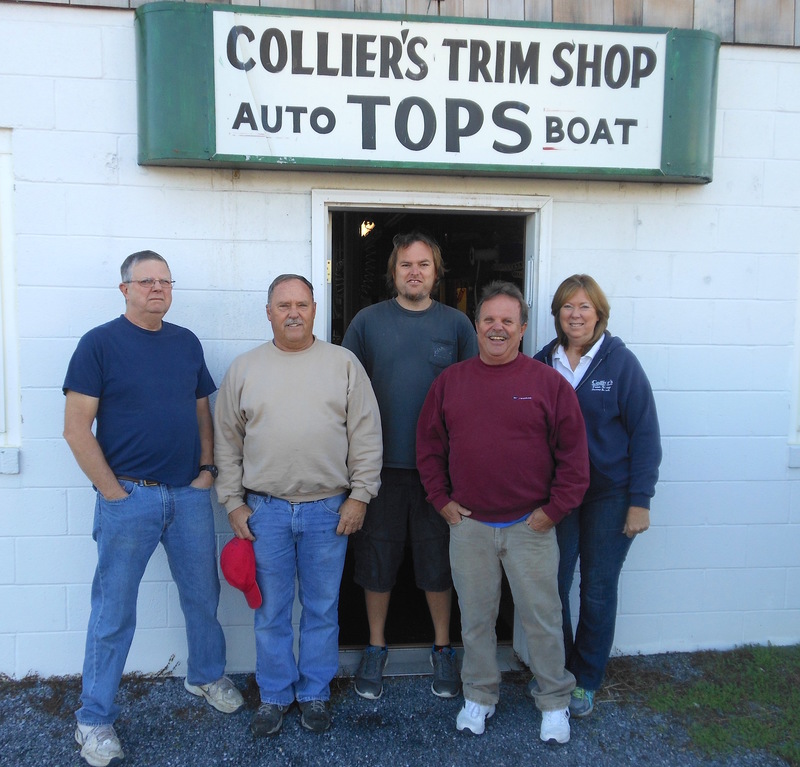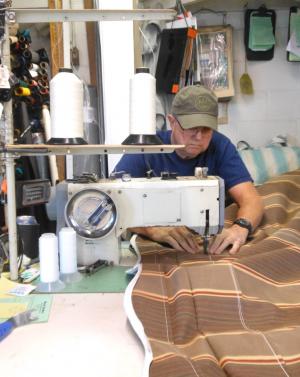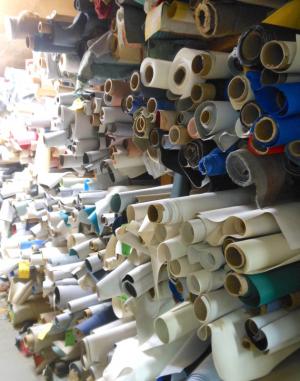Mike Sockriter & Mark Joseph: Keeping awnings looking sharp since the 1960s
Mike Sockriter has spent 44 years in the custom trim business, and he doesn’t see any reason why he’d stop anytime soon.
“I like what I do. If something works, why change it?” said Sockriter, 62. “Besides, I’ve got to do something. If I were home all day, I’d drive my wife nuts.”
Sockriter and stepbrother Mark Joseph are the owners of Collier’s Trim Shop in Dewey Beach. Sockriter got a job working for the business’ original owner, Al Collier, in 1971 after going to college for a couple of years.
“I always intended to go back, but I got married and had kids,” he said with you-know-how-it-goes shrug.
Joseph, 59, has been in the business just as long, starting in the shop at the age of 15. He said he came to visit his older stepbrother at the beach and was basically put to work.
Joseph said the company will occasionally do unusual custom requests. He said one time a Sussex Tech student with a prosthetic hand needed a glove sewn into place so he could take a welding class.
Sockriter said they’ve worked on muscle cars and boats, as well as modern and antique airplanes.
“We’ll do just about anything with upholstery, except furniture,” he said.
The company is as family-run as a business gets – Joseph and Sockriter are stepbrothers, and then there’s Scott Joseph, brother to Mark and stepbrother to Mike; Vanessa Joseph, Mark’s wife; and Victor Joseph, Mark and Vanessa’s son.
The elder Joseph said Victor, 32, also has been working for the trim ship since he was 15. He was brought on because he’s taller than everyone else, so he doesn’t need a ladder.
“I’m short,” said Mark Joseph, laughing.
Joseph said the company began in the 1960s when Collier opened the shop in Dewey after having worked for the Ford Motor Company. He had accounts from Smyrna to Berlin, Md., said Joseph.
The two men were handed the reins of the business in 1982, shortly before Collier died, said Joseph.
“He was a great man to work for,” said Joseph fondly.
When driving by Collier’s northbound Route 1 location, the shop could be mistaken for an old beach house with a first-floor garage made of cinder blocks. The business sign is decades old and the cedar shingles are weathered. It might be the only business on the town’s Route 1 strip that doesn’t cater to an immediate need of the hundreds of thousands of tourists who visit the town each summer.
The building, constructed in 1964, is a living museum to the trim and vinyl repair industry.
The sewing machines are decades-old German-made Pfaffs. Joseph said the industrial-grey machines are reliable, require little maintenance and get the job done. Holding his fingers half-an-inch apart, Joseph said the machines have been used to make straps for local fire companies.
They’ll also put a needle through a finger before the operator even knows what happened. “I’ve had to get needles cut out of my finger before,” he said, grabbing one of his pointer fingers.
The company also has a Singer double-stitch sewing machine – also decades old. Sockriter said Collier’s is the only local trim shop that has one, as he explained the benefits of a machine that can sew two lines of stitches at once. He said the machine stitches just as strong, yet more efficient.
Along the south wall, there’s an old clock from Snap-on tools hanging above Joseph’s sewing machine. The clock hands no longer work, but the woman with the 1980s perm dressed in hip-revealing lingerie is still smiling through a thick layer of faded shellac.
Joseph said he couldn’t remember the clock’s age, but the guy who is now the Snap-on sales representative has asked to buy it.
On shelves next to the clock are a dozen or so boxes of rusted seat springs for work truck models from the 1960s.
Big guys were driving those trucks, said Joseph, laughing.
A 5-foot wide storage room that runs the length of the building’s eastern wall is filled to capacity with rolls of unused awning and seat material. Joseph hesitated before allowing a photo of the rolls in the room because, he said, it was a big mess, but he chalked it up to providing a good selection to customers.
Joseph said a major advance in the industry has been the introduction of no-rot thread. Weathered seams are an aged awning’s weak spot, said Joseph, and this thread is hard to even burn.
Joseph said the company maintains 300 to 400 awnings – meaning, he said, three months are spent every spring putting awnings up and three months are spent every fall taking them back down.
“We’re the only company that maintains awnings,” he said. “We’ve got five storage containers where we keep them through the winter.”
Joseph said the phone rings off the hook when storms are predicted to roll through. He said the shop was getting 40 calls a day in early October when meteorologists were saying Hurricane Joaquin might hit Delaware.
“There’s no way to take down three months of awnings in three days, so we took care of the beach first.” he said.
Both Joseph and Sockriter said they like to get to the shop early because it’s easier to get work done before the phone starts ringing.
Sockriter said he’s in the shop between 6 and 6:30 a.m. He said the first few minutes are spent catching up on the previous evening’s sports, and then he walks down to the beach to watch the sun rise.
“That reminds you who’s really in charge,” he said.
















































